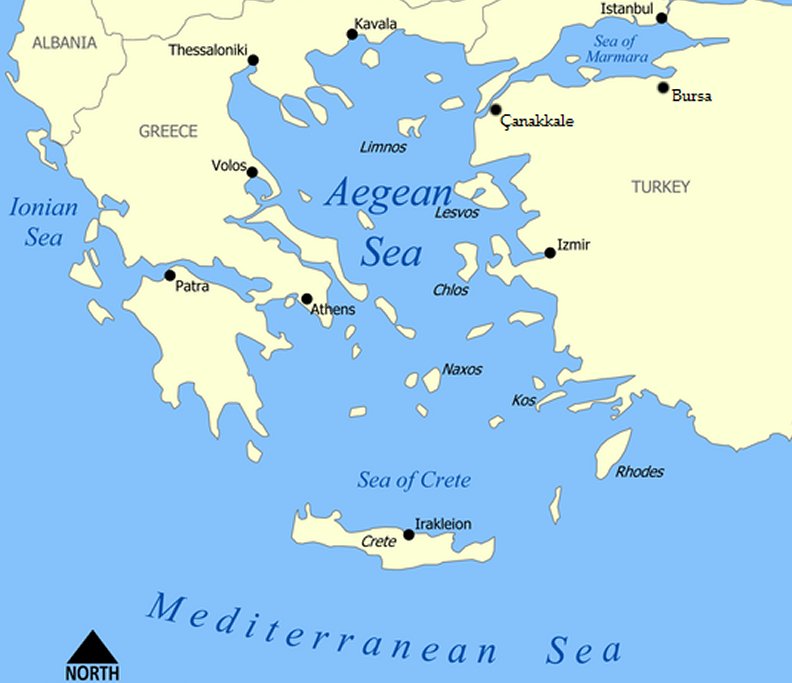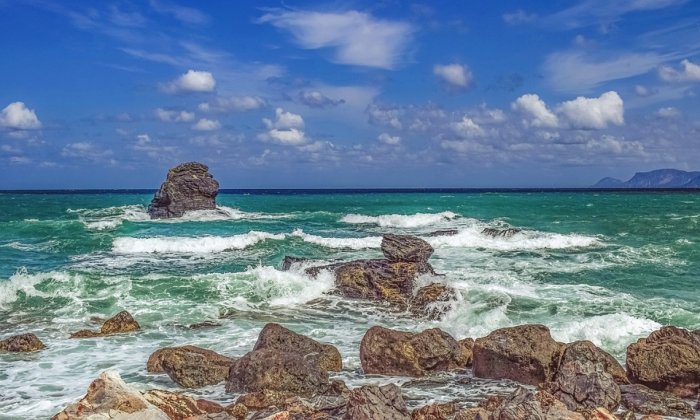Archaic Hominins Began Sea-Crossings The Aegean Sea 450,000 Years Ago
Conny Waters - AncientPages.com - A new study led by Georgios Ferentinos, and a team of researchers from the Greek University of Patras, shows evidence supporting the view, held by many scholars, that archaic hominins (early human ancestors) were sea-crossing the Aegean Sea.
Aegean Sea map shows the location of the Aegean Sea between Greece and Turkey. Created by Norman Einstein - CC BY-SA 3.0
According to the presented findings, there is substantial evidence that the archaic hominins had developed sea-crossing behaviors as early as last 450,000 years, at the time, the sea level was between 152 - 225 meters lower than it is today.
The subject of the archaic hominins' presence in the Aegean Sea Islands has been long debated. Now, it is known that archaic hominins, first visited the present-day Aegean islands as early as the mid-Middle Pleistocene.
However, it is also interesting whether they reached the region on foot or by sea.
The present agreement is that these people were crossing the Aegean on foot when the sea level was much lower during the ice age. The Aegean, then, was sub-aerially exposed and connected to the Hellenic Peninsula and Anatolia, Turkey.
These sea-crossings' travelers were encouraged by the favorable land/seascape configuration to attempt sea-crossings and spread to the Circum-Mediterranean basin leading from the Levant, and then, following two converging routes; the one via the Aegean Sea and/or the Bosporus land-bridge and the other via the Gibraltar straits.
Archaeological excavations have revealed thousands of flint tools in Crete dating back more than 130,000 years and even much older, possibly up to 700,000 years ago. On Greek islands - Lesbos, Milos and Naxos, there were excavated tools (from 1.2 million years ago) related to the tools of Homo Erectus in Africa and Asia date to 1.9 million years ago.
There is still valid question: How, could these tools have reached the Aegean islands?
Could it be that during a particularly extreme Ice Age event the sea level was so low that people could simply walk through these areas?
Ferentinos and his team very thoroughly reconstructed the geography of the entire region, including the continental coastlines that 450,000 years ago surrounded the Aegean islands.
Image credits: dimitrisvetsikas1969 - pixabay
Giorgos Ferentinos, professor emeritus of geology at the University of Patras, who led the study. During the coldest periods, the sea was more than 200 meters below its current level, Ferentinos and his colleagues report.
This means that many Aegean islands were connected to each other by land.
They also studied ancient river deltas that contributed with the information about sea level and land subsidence rates, driven by tectonic activity. What they discovered is that the reconstructions that had been done before were incorrect.
For example, at its lowest point in the last 450,000 years, the sea level was approximately 225 meters lower than it is today. Which means that while some of the Aegean islands may have been connected to each other when sea levels were lower, over the half million years studied they all remained consistently isolated from the surrounding landmasses. Even at the point where the sea level was lowest, you still had to cross several kilometers of open water to reach the nearest island from the mainland’
Over the past half a million years there have been five major glaciation events and five warmer periods., and during the coldest periods, the sea was more than 200 meters below its current level.
"This means that many Aegean islands were connected to each other by land. The Cyclades were essentially a large island. But it remained an island, surrounded by sea, cut off from the mainland for at least 5-7 kilometers in glacial conditions and 40 kilometers in warmer periods. However, the island would be visible from inland, offering an attractive incentive to explore new areas.
This does not prove that they built boats, but they could have created primitive rafts or simply floated by holding onto a tree trunk," wrote Hellas Posts English.
Written by Conny Waters - AncientPages.com Staff






















